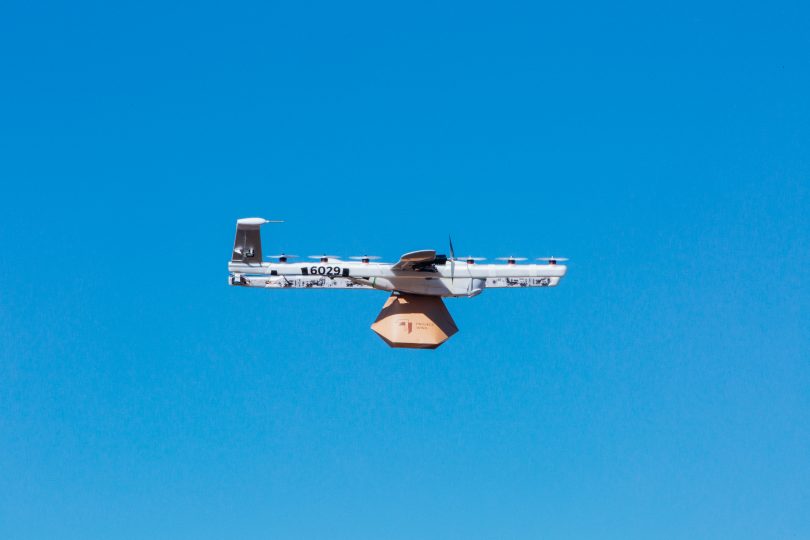
A Wing drone delivering a package. The company argues drone deliveries are the safest, fastest and most environmentally friendly mode of transport. Photo: Wing.
The introduction of a drone delivery service in the ACT would help the Territory meet its zero emissions goal and reduce congestion on Canberra’s roads, according to a new report.
Commissioned by Wing, which is preparing to trial drone delivery services in Canberra’s north next year from its new base in Mitchell, the report by AlphaBeta says that by 2030 drones could replace 6 per cent or 35 million kilometres of delivery-related road travel a year, and cut greenhouse gas emissions by about 8000 tonnes or the equivalent in carbon storage of almost 250,000 trees.
The report estimates that by 2030 there will be about 67 million household deliveries by road a year in the ACT.
“By delivering up to 4-6 per cent of transactions, drones could materially reduce the number of unnecessary vehicles on the road, reducing congestion and the associated greenhouse gas emissions,” the report says.
“Delivery vehicles are large, heavy and can disproportionately disrupt other road users. Parking and access to loading areas often delay and inconvenience other commuters and pedestrians. Delivery-related congestion in high-density areas has only increased in the era of ride-sharing and food delivery.”
It argues that with road transport responsible for nearly 70 per cent of the ACT’s emissions, and cars accounting for 44 per cent of emissions, electric-powered drones were perfectly placed to play a significant role in reducing the Territory’s emissions by replacing car journeys.
AlphaBeta says that by 2030 personal pick-ups via car will account for about three-quarters of transactions in the ACT and a 2018 study found that cars are the worst polluters, emitting an average of 4,600 grams of greenhouse gas per trip.
The study found that small drones emit 25 grams of greenhouse gas per last-mile delivery, compared with 296-728 grams for delivery trucks or vans, after accounting for the economies of scale that these trucks can achieve by delivering multiple packages along their route.
AlphaBeta says replacing 35 million vehicle-kilometres of road-based deliveries and pick-ups could also result in 70 fewer accidents a year.
The ACT Government has a target to achieve net zero greenhouse gas emissions by 2050 at the latest, with transport one of the biggest challenges. At present, the ACT emits 1.7 million tonnes of greenhouse gas each year.
Wing has lodged a development application to fit out its Mitchell warehouse and is conducting a publicity campaign in the northern suburbs of Franklin, Harrison, Crace, Gungahlin and Palmerston, where it plans to trial its service in 2019.
Wing CEO James Ryan Burgess said: “Drone delivery is the safest, fastest and most environmentally friendly mode of transport and we’re incredibly excited about the potential long-term benefits of drone delivery for Canberra in improving road safety and reducing vehicle emissions.”
Wing has received a hostile reaction to its Bonython trial in Canberra’s south, mainly over noise and privacy, including a petition tabled in the Legislative Assembly, and next year will also face an Assembly committee inquiry, which will look at the potential for cutting emissions, as well as noise and privacy.
Original Article published by Ian Bushnell on the RiotACT.







